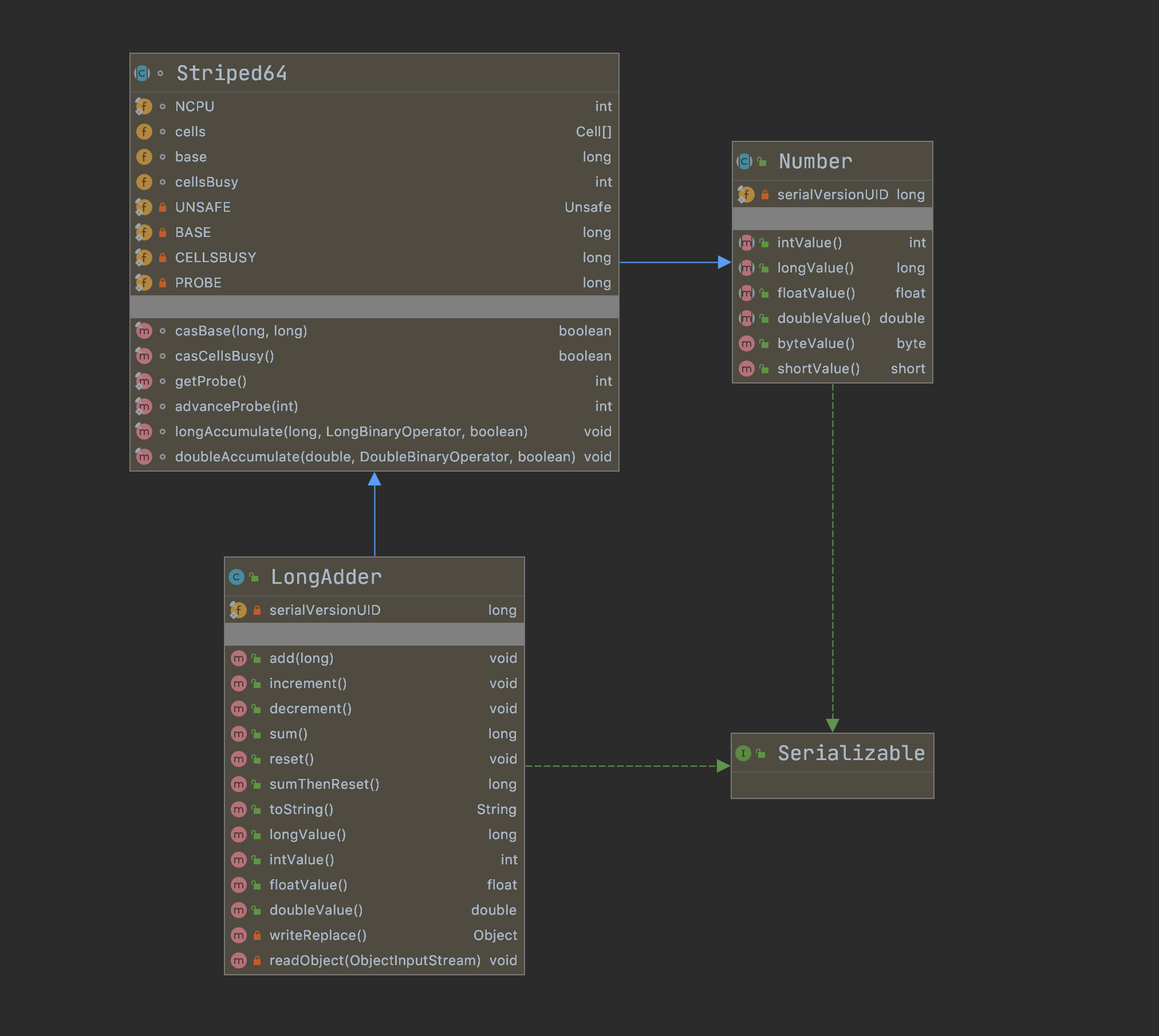在介绍 AtomicInteger 时,已经说明在高并发下大量线程去竞争更新同一个原子变量时,因为只有一个线程能够更新成功,其他的线程在竞争失败后,只能一直循环,不断的进行 CAS 尝试,从而浪费了 CPU 资源。而在 JDK 8 中新增了 LongAdder 用来解决高并发下变量的原子操作。下面同样通过阅读源码来了解 LongAdder 。
介绍
一个或多个变量共同维持初值为 0 总和。 当跨线程竞争更新时,变量集可以动态增长以减少竞争。 方法 sum 返回当前变量集的总和。
当多个线程更新时,这个类是通常优选 AtomicLong ,比如用于收集统计信息,不用于细粒度同步控制的共同总和。 在低更新竞争,这两个类具有相似的特征。 但在高更新竞争时,使用 LongAdder 性能要高于 AtomicLong,同样要消耗更高的空间为代价。
LongAdder 继承了 Striped64,内部维护一个 Cells 数组,相当于多个 Cell 变量, 每个 Cell 里面都有一个初始值为 0 的 long 型变量。
源码分析
Cell 类
Cell 类 是 Striped64 的静态内部类。
@sun.misc.Contended static final class Cell {volatile long value;Cell(long x) { value = x; }final boolean cas(long cmp, long val) {return UNSAFE.compareAndSwapLong(this, valueOffset, cmp, val);}// Unsafe mechanicsprivate static final sun.misc.Unsafe UNSAFE;private static final long valueOffset;static {try {UNSAFE = sun.misc.Unsafe.getUnsafe();Class<?> ak = Cell.class;valueOffset = UNSAFE.objectFieldOffset(ak.getDeclaredField("value"));} catch (Exception e) {throw new Error(e);}}}
- Cell 使用 _@_sun.misc.Contended 注解。
- 内部维护一个被 volatile 修饰的 long 型 value 。
- 提供 cas 方法,更新value。
其中 _@_sun.misc.Contended 注解作用是为了减少缓存争用。什么是缓存争用,这里只做下简要介绍。
伪共享 CPU 存在多级缓存,其中最小存储单元是 Cache Line,每个 Cache Line 能存储 64 个字节的数据。 在多线程场景下,A B 两个线程数据如果被存储到同一个 Cache Line 上,此时 A B 更新各自的数据,就会发生缓存争用,导致多个线程之间相互牵制,变成了串行程序,降低了并发。 _@_sun.misc.Contended 注解,则可以保证该变量独占一个 Cache Line。 详细可参考:http://openjdk.java.net/jeps/142
Striped64 核心属性
abstract class Striped64 extends Number {/** CPU 的数量,以限制表大小 */static final int NCPU = Runtime.getRuntime().availableProcessors();/*** cell 数组,当非空时,大小是 2 的幂。*/transient volatile Cell[] cells;/*** Base 值,在无争用时使用,表初始化竞赛期间的后备。使用 CAS 更新*/transient volatile long base;/*** 调整大小和创建Cells时自旋锁(通过CAS锁定)使用。*/transient volatile int cellsBusy;}
Striped64 类主要提供以下几个属性:
- NCPU:CPU 的数量,以限制表大小。
- cells:Cell[] cell 数组,当非空时,大小是 2 的幂。
- base:long 型,Base 值,在无争用时使用,表初始化竞赛期间的后备。使用 CAS 更新。
- cellsBusy:调整大小和创建Cells时自旋锁(通过CAS锁定)使用。
LongAdder#add
public class LongAdder extends Striped64 implements Serializable {public void add(long x) {Cell[] as; long b, v; int m; Cell a;// cells 是 数组,base 是基础值if ((as = cells) != null || !casBase(b = base, b + x)) {boolean uncontended = true;if (as == null || (m = as.length - 1) < 0 ||(a = as[getProbe() & m]) == null ||!(uncontended = a.cas(v = a.value, v + x)))longAccumulate(x, null, uncontended);}}}
abstract class Striped64 extends Number {// 使用 CAS 更新 BASE 的值final boolean casBase(long cmp, long val) {return UNSAFE.compareAndSwapLong(this, BASE, cmp, val);}// 返回当前线程的探测值。 由于包装限制,从ThreadLocalRandom复制static final int getProbe() {return UNSAFE.getInt(Thread.currentThread(), PROBE);}}

- 首先会对 Base 值进行 CAS 更新,当 Base 发生竞争时, 会更新数组内的 Cell 。
数组未初始化,Cell 未初始化, Cell 更新失败,即 Cell 也发生竞争时,会调用 Striped64 的 longAccumulate 方法。
Striped64#longAccumulate
abstract class Striped64 extends Number {/*** x 要增加的值* wasUncontended 有没有发生竞争*/final void longAccumulate(long x, LongBinaryOperator fn, boolean wasUncontended) {int h;// 当前线程有无初始化线程探测值, 给当前线程生成一个 非 0 探测值if ((h = getProbe()) == 0) {ThreadLocalRandom.current(); // force initializationh = getProbe();wasUncontended = true;}boolean collide = false; // True if last slot nonempty// 循环for (;;) {Cell[] as; Cell a; int n; long v;// 数组不为空切数组长度大于 0if ((as = cells) != null && (n = as.length) > 0) {// (n - 1) & h 获取到索引,索引处 cell 是否为 null, cell未初始化if ((a = as[(n - 1) & h]) == null) {// 判断 cellsBusy 是否为 0if (cellsBusy == 0) { // Try to attach new CellCell r = new Cell(x); // Optimistically create// cellsBusy == 0 且 使用 casCellsBusy 方法将其更新为 1,失败会继续循环if (cellsBusy == 0 && casCellsBusy()) {boolean created = false;try { // Recheck under lockCell[] rs; int m, j;// 重新检查状态 并创建if ((rs = cells) != null && (m = rs.length) > 0 && rs[j = (m - 1) & h] == null) {rs[j] = r;created = true;}} finally {// 创建完成之后, 改回 cellsBusy 值cellsBusy = 0;}if (created)break;// 未创建继续循环continue; // Slot is now non-empty}}collide = false;}// 传入的 wasUncontended 为 false 即发生碰撞了, 修改为未碰撞, 此处会继续循环,走到下一步,相当于会一直循环这个 cellelse if (!wasUncontended) // CAS already known to failwasUncontended = true; // Continue after rehash// cas 更新 cell 的 value, 成功则返回else if (a.cas(v = a.value, ((fn == null) ? v + x : fn.applyAsLong(v, x))))break;// 数组到最大长度 即大于等于 CPU 数量, 或者 cells 数组被改变,else if (n >= NCPU || cells != as)collide = false; // At max size or staleelse if (!collide)collide = true;// 乐观锁 进行扩容else if (cellsBusy == 0 && casCellsBusy()) {try {if (cells == as) { // Expand table unless staleCell[] rs = new Cell[n << 1];for (int i = 0; i < n; ++i)rs[i] = as[i];cells = rs;}} finally {cellsBusy = 0;}collide = false;continue; // Retry with expanded table}// 当前探针值不能操作成功,则重新设置一个进行尝试h = advanceProbe(h);}// 没有加 cellsBusy 乐观锁 且 没有初始化,且获得锁成功(此时 cellsBusy == 1)else if (cellsBusy == 0 && cells == as && casCellsBusy()) {boolean init = false;try { // Initialize tableif (cells == as) {Cell[] rs = new Cell[2];rs[h & 1] = new Cell(x);cells = rs;init = true;}} finally {cellsBusy = 0;}if (init)break;}// 尝试在base上累加else if (casBase(v = base, ((fn == null) ? v + x : fn.applyAsLong(v, x))))break; // Fall back on using base}}}
longAccumulate 方法一共有三种情况
(as = cells) != null && (n = as.length) > 0数组不为空且长度大于 0 。- 获取索引处的 cell , cell 为空则进行初始化。
- cell 不为空,使用 cas 更新, 成功
break;跳出循环, 失败则还在循环内,会一直尝试。 - collide 指是否发生冲突,冲突后会进行重试。
- 冲突后会尝试获得锁并进行扩容,扩容长度为原来的 2 倍,然后继续重试。
- 获得锁失败(说明其他线程在扩容)会重新进行计算探针值。
cellsBusy == 0 && cells == as && casCellsBusy()数组为空,获得乐观锁成功。- 直接初始化数组。
- 初始数组长度为 2 。
casBase(v = base, ((fn == null) ? v + x : fn.applyAsLong(v, x)))获得乐观锁失败。数组为空,说明没有发生竞争,直接返回 base 。
数组不为空,说明发生竞争,累加 cell 的 value 和 base 的和进行返回。
总结
基本流程
LongAdder 继承了 Striped64,内部维护一个 Cells 数组,相当于多个 Cell 变量, 每个 Cell 里面都有一个初始值为 0 的 long 型变量。
- 未发生竞争时(Cells 数组未初始化),是对 base 变量进行原子操作。
- 发生竞争时,每个线程对自己的 Cell 变量的 value 进行原子操作。
如何确定哪个线程操作哪个 cell?
通过getProbe()方法获取该线程的探测值,然后和数组长度n - 1做&操作 (n - 1) & h 。static final int getProbe() {return UNSAFE.getInt(Thread.currentThread(), PROBE);}
Cells 数组初始化及扩容?
初始化扩容时会判断cellsBusy, cellsBusy 使用volatile修饰,保证线程见可见性,同时使用 CAS 进行更新。 0 表示空闲,1 表示正在初始化或扩容。
初始化时会创建长度为 2 的 Cell 数组。扩容是创建一个长度是原数组长度 2 倍的新数组,并循环赋值。
如果线程访问分配的 Cell 元素有冲突后,会使用advanceProbe()方法重新获取探测值,再次进行尝试。使用场景
在高并发情况下,需要相对高的性能,同时数据准确性要求不高,可以考虑使用 LongAdder。
当要保证线程安全,并允许一定的性能损耗时,并对数据准确性要求较高,优先使用 AtomicLong。


